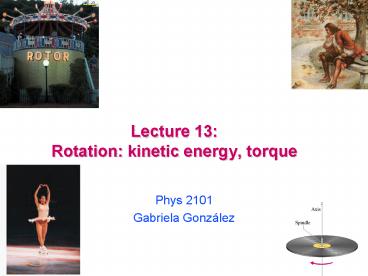Lecture 13: Rotation: kinetic energy, torque - PowerPoint PPT Presentation
1 / 11
Title:
Lecture 13: Rotation: kinetic energy, torque
Description:
... of 8.7x104 kg m2, and a (front) face width of 2.4 m. Neglecting ... What is the tension in the part of the cord that supports (b) the heavier block and ... – PowerPoint PPT presentation
Number of Views:244
Avg rating:3.0/5.0
Title: Lecture 13: Rotation: kinetic energy, torque
1
Lecture 13Rotation kinetic energy, torque
- Phys 2101
- Gabriela González
2
Kinetic energy
Kinetic energy
3
Moments of Inertia
4
Parallel Axis Theorem
Four identical particles of mass 0.50 kg each are
placed at the vertices of a 2.0mx2.0m square and
held there by four massless rods, which form the
sides of the square. What is the rotational
inertia of this rigid body about an axis that
(a) passes through the center of mass, and the
midpoints of opposite sides (lies in the plane of
the square)? (b) Is the rotational inertia the
same if the axis through the center of mass is
perpendicular to the plane? (b) What is the
rotational inertia if the axis passes through two
particles on contiguous corners and lies in the
plane of the square?
Moment of inertia with respect to an arbitrary
rotation axis
5
Torque
How effective is a force to produce rotation?
Torque Force x distance x sin(angle)
Positive if the force produces a ccw
rotation negative if the force produces a cw
rotation.
6
Example
- The body in Fig. 11-38 is pivoted at O. Three
forces act on it in the directions shown FA 10
N at point A, 8.0 m from O FB 16 N at point B,
4.0 m from O and FC 19 N at point C, 3.0 m
from O. What is the net torque about O?
7
Torque and rotation Newtons law
8
Example
- The figure shows the massive shield door at a
neutron test facility at Lawrence Livermore
Laboratory this is the world's heaviest hinged
door. The door has a mass of 44,000 kg, a
rotational inertia about a vertical axis through
its huge hinges of 8.7x104 kgm2, and a (front)
face width of 2.4 m. Neglecting friction, what
steady force, applied at its outer edge and
perpendicular to the plane of the door, can move
it from rest through an angle of 90 in 30 s?
9
Example
- In the figure, a block has mass M 500 g, the
other has mass m 460 g, and the pulley, which
is mounted in horizontal frictionless bearings,
has a radius of 5.00 cm. When released from rest,
the heavier block falls 75.0 cm in 5.00 s
(without the cord slipping on the pulley). (a)
What is the magnitude of the blocks'
acceleration? What is the tension in the part
of the cord that supports (b) the heavier block
and (c) the lighter block? (d) What is the
magnitude of the pulley's angular acceleration?
(e) What is its rotational inertia?
10
Work, energy, power
We know all of that already!!
11
Example
- A meter stick is held vertically with one end on
the floor and is then allowed to fall. Assuming
that the end on the floor does not slip - (a) What forces are acting on the stick?
- (b) What forces are doing work?
- (c) Find the speed of the other end when it hits
the floor.































